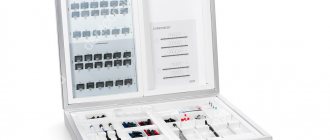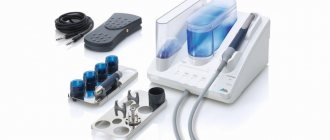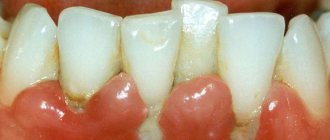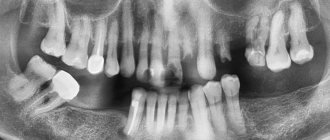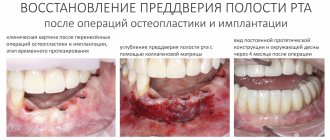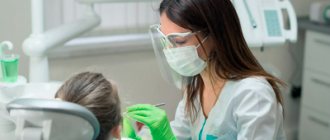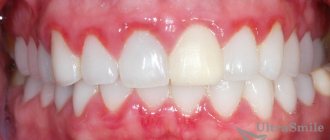HomePeriodontologyTreatment of periodontal disease with SIEMENS laser
The main reason patients visit a dental clinic is severe pain. Different diseases of the teeth and gums may have similar symptoms, and only a specialist can make an accurate diagnosis. The most common is periodontal disease. If treatment is not started in a timely manner, the development of the disease leads to inevitable tooth loss. Therefore, it is necessary to contact a dentist when the first symptoms of the disease occur.
Causes of periodontal disease development
The appearance of periodontal disease occurs for various reasons. As a result of examining more than 750 thousand patients, US scientists found that the disease primarily develops due to bacterial plaque on the teeth and a decrease in the body’s immune defense. It has been established that microorganisms that live in deposits and plaque on teeth are directly related to the development of the disease. It is the waste products of these microbes that have a negative effect on the gums and dental tissue, causing their destruction.
First, a person notices bleeding gums while brushing their teeth, which can also be accompanied by pain. Therefore, the process of oral and dental hygiene becomes more careful and of lower quality. As a result, plaque only increases, turning into tartar. At the same time, the environment for the development of microorganisms becomes especially beneficial.
During this time, inflammation and periodontal condition only worsens. Moreover, the negative process affects the activity of microvessels, which reduces nutrition, accelerating destruction. After this, the inflammatory phenomenon affects the bone tissue.
Another reason for the development of periodontal disease lies in the disruption of immune defense. The human body can be subject to disruptions due to stressful situations, trauma, and hormonal problems. As a result, immune cells perceive periodontal tissues as foreign and attack them. Such exposure causes aseptic inflammation of the gum tissue with subsequent death. Then the negative process moves to the bone tissue. The third stage of the disease is characterized by loosening and loss of teeth.
The following factors can aggravate the course of the disease: diabetes, smoking, gastrointestinal disorders, stress, hormonal imbalances, advanced caries, poor dentures and malocclusion.
Common oral diseases
To keep your teeth healthy and not lead to the need for treatment of periodontal disease, you need to know about the most popular diseases of the oral cavity and the methods of their manifestation. The danger of oral pathologies is that many ailments at the initial stage have mild symptoms; it is extremely difficult to identify disorders even for an experienced physician, especially if there are no complaints from the patient. Soft tissue diseases can hide for a long time, without causing discomfort and only months after their occurrence leading to the need for treatment of periodontal disease. Progress in medicine in general and dentistry in particular has stepped forward noticeably, as can be seen from the statistics. If at the beginning of the 20th century almost half of the Russian population suffered from this disease, today the need for treatment of periodontal disease is observed in only 7% of the adult population of the country. This happened, first of all, due to the competent educational work of enthusiasts, thanks to whom people understood: without constant oral care it is impossible to maintain healthy teeth and a beautiful smile. In addition to the treatment of periodontal disease, visitors to dental clinics most often suffer from the following diseases.
- Gingivitis is a process of inflammation, which is usually caused by weakened immunity, previous colds and infectious diseases. Timely consultation with a doctor allows you to get rid of the disease easily and painlessly.
- Periodontitis is a consequence of incompletely cured gingivitis. Leads to thinning of bone tissue, causes destruction and loss of teeth. If the problem is not addressed in a timely manner, gum atrophy and tissue death of the alveolar process may occur.
- Stomatitis is an infectious disease caused by the creation of microflora favorable for the development of bacteria. It is most often observed in children. Small white sores on the mucous membrane are well known to many parents.
DO NOT FORGET! Since the causes and symptoms of diseases differ, the treatment of periodontal disease and any other pathologies requires a comprehensive examination in a modern laboratory. It is worth keeping in mind that without complete cure of gum disease, prosthetics or implantation are impossible. Therefore, soft tissues need to be given special attention when trying to keep teeth healthy.
Periodontal disease - symptoms and signs
The first signs of the development of the disease include:
- Itching and discomfort in the gums;
- Bleeding while brushing teeth;
- Swelling and change in the shape of the gums;
- Unpleasant odor;
- Specific salty taste in the mouth.
If therapy is not started in a timely manner, purulent lesions will soon form in the gums. Pain increases, its color, shape and structure change.
In such cases, enlarged lymph nodes cannot be ruled out. And x-rays will show pathological changes in bone tissue with inflammatory foci and destruction of interdental septa.
Indications and contraindications
Laser treatment technology is an effective method for eliminating various pathologies. The targeted effect makes the treatment safe for surrounding tissues; it is used for endodontic intervention and to eliminate growths. The main indications for using the laser method are:
- gingivitis of any form;
- periodontal disease;
- fibromas, soft tissue hemangiomas;
- periodontitis;
- cleaning, sterilization of gum pockets;
- treatment of granulomas, fistulas, removal of growths.
Despite the safety and effectiveness of laser treatment, the method cannot always be used. Contraindications include:
- diseases of the cardiovascular system, lungs;
- pathologies of the endocrine system;
- bleeding disorders;
- mental disorders, nervous system functioning;
- condition after surgery.
The use of laser treatment of gums is allowed for children, pregnant women, and elderly patients. The therapy is safe and does not involve traumatic contact with tissues.
Periodontal disease - how is it diagnosed?
Correct treatment of periodontal disease is possible only after a thorough diagnosis. However, one examination by a dentist will not be enough. You should undergo tests using modern equipment and drugs.
In the dental practice of the Bionic Dentis clinic, the German protocol is used to examine patients. This allows you to conduct a full examination and accurately make a diagnosis.
This examination includes:
- Inspection using an optical system that allows you to significantly enlarge the inspected surface and not miss even the slightest damage;
- Testing for hidden plaque on teeth. To do this, a special preparation is applied, which indicates the places where harmful microbes accumulate;
- Determination of inflammation using a marker drug that can indicate lesions;
- Bana testing, which helps identify microorganisms that cause the development of the disease. Thanks to this technique, a competent selection of antibacterial therapy occurs. Specialists from the Bionic Dentis clinic were among the first to conduct bana testing in Russia;
- An X-ray and orthopantomographic examination procedure that allows you to assess the condition of all dental tissues that are not visible during a simple examination. This helps prevent and prevent further development of inflammation.
After reviewing the results of a complete diagnosis of the patient, specialists at the Bionic Dentis clinic draw up a treatment plan. This approach allows us to completely cure 99% of patients suffering from periodontal disease who contact us.
Benefits of laser treatment
Various types of lasers are used in dentistry:
- Carbon dioxide.
- Diode.
- Erbium.
It is selected by the doctor depending on the disease, affected tissues and other indications. For example, carbon dioxide and diode lasers are used in the treatment of soft tissues, and erbium lasers are used for hard tissues. During the procedure, the laser beam does not come into contact with tissues, does not burn them, it evaporates water and kills pathogenic bacteria. The patient does not feel any discomfort either during or after the operation.
Laser technologies are superior to traditional ones in many respects:
- Efficiency. The laser beam sterilizes the periodontal canal, penetrating into hard-to-reach places. Thanks to this, pathogenic microflora is completely destroyed. Using laser methods, doctors at our clinic not only successfully treat gum disease, but also prevent their recurrence.
- Beneficial effect on tissue. The laser beam polishes the tooth tissue, removes gaps and depressions. This helps prevent further entry and spread of pathogenic microorganisms into the subgingival area.
- Low morbidity. Laser treatment is minimally invasive. During the procedure, you will feel absolutely no pain. Healthy tissues are not damaged. The blood vessels are immediately coagulated, which completely eliminates bleeding. The use of laser has virtually no contraindications; it can be used to treat gum diseases in children and pregnant women.
- Long-term results. An environment favorable for the proliferation of pathogenic microorganisms is not created in the treated area. After sterilization, the effect lasts for a long time.
- High accuracy. The laser beam can only treat the affected areas without affecting healthy tissue. None of the traditional dental methods can achieve such high precision.
Laser treatment has virtually no contraindications. Laser technologies cannot be used if you have severe diseases of the cardiovascular system, open form of tuberculosis, or insulin-dependent diabetes mellitus.
Stages of a unique technique:
- 1. Begin therapy with ultrasonic cleansing of the entire tooth and its root. This removes plaque and stones. The use of ultrasound allows you to thoroughly clean even the most difficult to reach areas without pain or injury to the enamel. Specialists at the Bionic Dentis clinic perform this procedure using a special Sirosonic Sirona Siemens ultrasound device, manufactured in Germany. In this case, the level of processing is selected individually, which significantly increases work efficiency.
- 2. The second stage includes the removal of pigmented plaque and microscopic deposits located in hard-to-reach places. For this, the Air Flow technique is used. The method is implemented using a Prophyflex dental handpiece from the German company Kavo, from which mixed air and abrasive are released under high pressure. This mixture allows you to effectively eliminate the remains of infection and other contaminants. The peculiarity of the method is the use of calcium carbonate, which has a gentle effect on the gums and root system of the tooth. In combination of this drug with the Prophyflex device from Kavo, the procedure is performed with the utmost quality.
- 3. At the third stage, laser sterilization of the root pockets and gum edges is performed. Doctors at Bionic Dentis use the Sirolaser Sirona Siemens dental laser (Germany). The laser tip is inserted into the gum pockets, which leads to the complete destruction of pathogenic bacteria that cause the disease. The unique laser setting allows not to damage the gums, but to have a detrimental effect on microbes.
- 4. The fourth stage includes drug therapy using calcium copper hydroxide. The medicine is placed in the gum pockets, leaving it there for a long time. The drug relieves inflammation and sterilizes periodontal pockets in which the pathological process has begun. Our specialists use a patented original drug from the German company Humanchemie. This manufacturer is also the developer of this medicine.
- 5. At the fifth stage, the metabolism in the gingival tissues is corrected. For this purpose, the active tissue regeneration complex prf is used. The patient first donates blood from a vein, which is subjected to special treatment. This makes it possible to isolate specific prf proteins. It is these substances that can trigger tissue restoration and healing processes in the human body. Due to the fact that the proteins are obtained from the blood of a specific patient, there are no side effects or allergic manifestations. The process of obtaining active proteins for regeneration is an important and responsible procedure, which is performed under strictly sterile conditions. For this purpose, Bionic Dentis specialists use a method invented by scientists from the Munich and Charité clinics (Germany).
Stages of treatment
The order of actions performed depends on the chosen methods and the condition of the tissues:
- deepithelialization is used to restore tissue, remove affected areas, stimulate the growth of connective cells and regeneration;
- gingivectomy consists of trimming the edge, removing the affected part of the mucosa and effectively treating periodontitis;
- Curettage is used to treat deep pockets and remove pathological growths.
Advantages
The main advantages of laser treatment for purulent inflammation of the gums are:
- the manipulations are painless, the use of anesthesia is not always required;
- tissue trauma is minimal, sutures are not required in all cases;
- no bleeding even during complex interventions;
- there is no pain during the rehabilitation period;
- the set of contraindications is minimal;
- the intervention area is small, there is no risk of infection;
- instantaneous coagulation of blood vessels;
- procedures are performed contactlessly;
- recovery and regeneration are fast.
The only disadvantage is the high cost. It should also be noted that not all clinics have the appropriate equipment, and the doctor working with the laser must have the appropriate training and qualifications.
Price
The price of treatment is calculated based on the following factors:
- condition of the oral cavity, the presence of diseases to be treated;
- performing office cleaning of stone and soft debris;
- causes of the disease;
- selected treatment methods and medications;
- the effectiveness of the measures taken, the frequency of doctor visits.
The dentist can tell you the exact cost after an initial examination and diagnostic measures. The price is based on the chosen therapy techniques, medications, and frequency of visits to the dentist. Prices are also influenced by the need for surgical intervention, which is likely in advanced stages.
Why choose us
Magenta Dental Clinic offers:
- comprehensive services, including treatment of gum disease in adults;
- use of modern treatment techniques and certified drugs;
- individual approach;
- guarantee of quality and effectiveness of treatment;
- affordable prices and interesting conditions.
To make an appointment, leave a request on the website or call by phone. You can ask our specialists questions about treatment, diagnostics and prices for services or send a request by email
What antibiotics are prescribed for the treatment of periodontal disease?
When contacting a specialist in a severe stage of periodontal disease, you cannot do without prescribing antibacterial therapy.
Antibiotics must be prescribed if:
- Pus was found in periodontal pockets;
- There are putrefactive-necrotic inflammations of the gingival tissue;
- The bone tissue is affected by purulent foci.
Antibacterial agents with a wide spectrum of action are used in dental practice. They show rapid activity in pathologies of any complexity, causing the death of harmful microorganisms.
The Bana test, which is used at the Bionic Dentis clinic in diagnosing periodontal disease, allows you to select effective drugs taking into account a specific clinical case.
Symptoms of the disease
Even if you follow all the specialist’s recommendations received during a preventive examination, there is no 100% guarantee that you will avoid the possibility of treating periodontal disease. This largely depends on objective aspects that do not depend on a person’s desire. Poor environment, poor-quality food, genetic predisposition, previous infectious diseases, damage and trauma are factors that increase the risk of needing treatment for periodontal disease. Do not forget about the condition of the internal organs. Excess weight, metabolic disorders, diabetes mellitus, poor vascular permeability, and gastrointestinal problems are among the reasons that may lead to the need for treatment of periodontal disease. Even slight swelling of the gums or bleeding during hygiene procedures should be a reason for immediate contact with a specialist. What symptoms directly indicate the need for treatment of periodontal disease?
- Changing the color of the gums to a red-blue tint.
- Rash on the oral mucosa.
- Pain when chewing food and brushing teeth.
- Itching, tingling, numbness of the alveolar ridge.
- Unit mobility is too high.
- Presence of tartar and soft deposits.
- Lead taste on tongue, bad breath.
- Exposure of the neck, peeling of gum tissue.
ATTENTION! Another sign of the possible presence of a disease is the formation of interdental gaps. Some people do not pay attention, attributing the process to age-related deformation of the maxillofacial system. It is not right. Expansion of the interdental space, especially if it began suddenly and has a steady tendency to increase, may indicate the need for treatment of periodontal disease.
The process of treating periodontal disease at home includes:
- Mandatory brushing of teeth after each meal with Parodontax medicinal periodontal paste, widely used at any stage. The best tool for cleaning teeth is the Sensodyne medium toothbrush, which has medium hardness. You should also use a thin and flexible dental brush for the morning and evening procedures;
- Daily use in the evenings of an oral irrigator - a special device that cleanses the teeth and massages the gums using a stream of water and air. This improves blood flow in the vessels, has a positive effect on the condition of the periodontium, and reduces inflammation of the gingival tissue. The best irrigator is Braun Oral-B.
- Rinse your mouth thoroughly after eating using a special product;
- Lubricating the gums with Asepta gum balm, which eliminates pain and inflammation, exhibiting a disinfectant and healing effect.
- These products can be used as prescribed by a specialist, after the procedure for treating periodontal disease with ultrasound and active prf regeneration proteins has been carried out.
An integrated approach in the form of a clinical and home therapeutic course will ensure a positive result and maximum effect.
The important role of gums
Healthy gums, allowing you to avoid periodontal treatment, play a huge role in creating a person’s image and maintaining health. First of all, this is a bed for teeth, the convenience of which determines the safety of each element. The comfort of units depends not only on regular care, proper diet, and compliance with medical recommendations, but also on the health of the supporting soft tissues. The second function of gums is protective. They prevent pathogens from entering deep into the maxillofacial system, which is exactly what happens when periodontal disease treatment is required. This disease, despite not being very widespread, even today seems very dangerous. The achievements of modern dentistry are not always able to protect a person from undesirable consequences. If periodontal disease treatment is not started on time, gum abscess may begin, which will lead to destruction and loss of teeth, and death of alveolar tissue. But unpleasant consequences can be avoided if preventive measures are carried out regularly. They are also considered as one of the methods of treating periodontal disease. What procedures are most in demand?
- Darsonvalization - exposure to high-frequency current. Due to this, there is an increase in blood flow to the gums, which saturates them with oxygen and substances necessary for stable functioning.
- Ultrasound – its influence is difficult to overestimate. It is used to regenerate tissue, accelerate healing processes, and reduce the risk of inflammation. In addition, this is an effective method of removing tartar, which we will discuss below.
- Massage is one of the most effective methods for normalizing work processes in soft tissues. In addition to manual massage, there are vibration, vacuum, and hydromassage, which have a positive effect on the overall well-being and tone of the body.
- Mud therapy is one of the oldest methods of maintaining oral health. Lightly heated raw materials are applied to the problem area, and the lotion is left for 20–30 minutes. This method of prevention is carried out in courses.
ON A NOTE! One of the types of mud therapy is paraffin therapy. The duration of the session is at least 3 hours. For medicinal purposes, special paraffin is used that does not contain harmful substances and components that cause allergies.
Periodontal disease treatment cost
To determine the cost of the entire course, it is important to know what mandatory procedures it includes:
- Diagnosis of gum condition, selection of medications and products for home use;
- Deep laser cleaning of gums;
- Course therapy with laser and injections of active regeneration proteins prf.
If necessary, additional measures are prescribed:
- Splinting of mobile teeth using fiberglass;
- Making a relaxation mouthguard.
As a result, the average cost of mandatory procedures that are included in the course of treatment of periodontal disease with laser and prf is 140,000 rubles.
The price of splinting teeth on one jaw using fiberglass is 35,000 rubles.
Production of a relaxation mouth guard – 20,000 rubles.
Why is periodontal disease treatment expensive?
Course treatment of periodontal disease is a high-tech process, which is performed by highly qualified specialists. In their work, doctors use expensive modern equipment and original medications produced in Germany.
The Bionic Dentis dental clinic has a full arsenal of high-tech equipment: a laser, a dental orthopantomograph, a blood processing system for isolating active prf regeneration proteins, the cost of which is several million rubles.
At the Bionic Dentis clinic, patients are guaranteed the authenticity of all equipment and medications. This is confirmed by certificates of conformity and registration certificates of Roszdravnadzor.
To provide affordable treatment to a wide range of patients, the Bionic Dentis clinic offers interest-free installments for a year.
The down payment is 30% of the total cost of treatment. The remaining amount is distributed evenly over 12 months.
Russian citizens aged 18-70 years can apply for an installment plan in just 15 minutes.
Laser sterilization
Where teeth are located, the gums form a periodontal pocket. In a healthy person it has a shallow depth. In the absence of normal oral hygiene, plaque accumulates on the surface of the teeth. Gradually it mineralizes, turns into stone and spreads under the gum. As tartar grows, it increases the depth of the gum pocket. Inflammation develops. The tissues that hold the tooth begin to break down. Mobility of the tooth appears, and in advanced cases it falls out.
One of the tasks that the periodontist must solve during treatment is sterilization of the periodontal pocket and elimination of pathogenic microflora in it.
For this purpose, the ARDC clinic uses a laser. During diagnosis, the periodontist determines which gum tissues are affected by the inflammatory process, the degree of their damage and other features of the clinical picture. Depending on them, he selects the type of laser:
- Carbon dioxide and diode lasers. Used when inflammation affects only soft tissues. They are effective in the early stages of periodontitis.
- Erbium laser. It is used if inflammation has spread to hard tissue. Treatment with an erbium laser is indicated in the later stages of periodontitis, with an aggressive course of the disease.
During the procedure, the doctor acts with a laser beam on the surface of the periodontal pocket. The laser evaporates the affected cells and kills pathogens. In this case, the beam does not injure the treated area, since the coagulation process occurs. A protective photocoagulation film is formed on the surface of the tissue.
Dentistry for those who love to smile
+7
Make an appointment
How to find a specialist to treat periodontal disease?
Carrying out full treatment of periodontal disease requires modern equipment and imported drugs. But the main thing is a specialist with the necessary knowledge and experience. Therefore, when choosing a periodontist, it is important that he has a certificate confirming the specialist’s qualifications. Also, the doctor must be trained in the treatment of periodontal disease using a laser and active prf regeneration proteins.
The specialists of the Bionic Dentis clinic are highly qualified and have specialized medical education. They have certificates confirming that they have completed training with German specialists.
The average experience of our periodontists is 10 years. They regularly participate in international conferences on clinical periodontology.
When choosing a periodontist, an important point is confidential communication with the patient. If a specialist explains the main features of the procedures, talks about the effects of the drugs used, possible side effects, contraindications and other aspects, then you have found your doctor!
Werner Elena Vladimirovna
Dentist periodontist
More details

